#Karelian folklore
Photo

Tapio – The Finnish god of forests and the hunt
Tapio is a Finnish forest spirit or god in Finnish mythology. Hunters prayed to him before a hunt. His wife is the forest goddess, Mielikki (Ref). He is the father of Annikki, Tellervo, Nyyrikki (the god of hunting), and Tuulikki. Fitting the Green Man archetype, Tapio has a beard of lichen and eyebrows of moss.
Tapio is a major character in Kalevala, the Finnish national epic based on Finnish and Karelian folklore, the hero Lemminkäinen offers him and Mielikki prayers, gold and silver so he can catch the Hiisi elk.
Tapio, the personified forest, was sometimes depicted as being the size of a fir tree, fierce-looking, like a human being in the front, but like a gnarled old tree from behind. Often the forest deity was female, occasionally an especially beautiful woman, who enticed hunters or woodcutters staying in the woods overnight; but he, too, turned out to be a rotten old stump upon closer scrutiny. The various forest deities and spirits were generally capricious in nature and had to be constantly placated by those who were dependent on their favours. Thus hunters made offerings to the deity and made sure they did not break any taboos in the forest, such as making excessive noise or shooting unusual birds that might be the forest spirit in disguise.
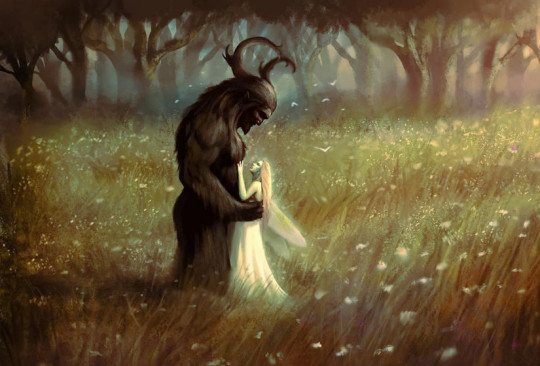
木にまつわる伝説・神話
伝説の樹木の神々 (18)
タピオ 〜 フィンランドの森と狩りの神
タピオはフィンランド神話に登場する森の精霊、または神である。彼の妻は森の女神ミエリッキ(参照)である。アンニッキ、テレルヴォ、ニャイリッキ (狩猟の神)、トゥーリッキの父である。タピオは、グリーンマンの原型にふさわしい人物で、地衣類の髭と苔の眉毛を持っている。
タピオは、フィンランドとカレリアの民話に基づくフィンランドの民族叙事詩『カレワラ』の主要人物である。『カレワラ』では、英雄レミンカイネンがヒイシのヘラ鹿を捕まえるために、彼とミエリッキに祈りと金と銀を捧げている。
森の精霊を擬人化したタピオは、モミの木の大きさで、正面から見ると人間のような獰猛な姿をしているが、後ろから見るとニョロニョロの老木のような姿で描かれることもあった。また、森の神は女性であることが多く、特に美しい女性で、森に一晩滞在する猟師や木こりを誘うこともあったが、彼もよくよく観察すると、腐った古い切り株であることが判明する。森の神々や精霊は気まぐれな性格で、その恩恵にあずかる者は常になだめなければならなかった。そのため、猟師は神に供物を捧げ、森での禁忌を破らないように気をつけた。例えば、過剰に音を立てたり、森の精霊の変装かもしれない珍しい鳥を撃ったりしないようにした。
#trees#tree legend#tree myth#tapio#mielikki#kalevala#karelian folklore#finish mythology#god of forests#tree spirit#lemminkäinen#legend#myths#folklore#green man#nature#art#forest
188 notes
·
View notes
Text
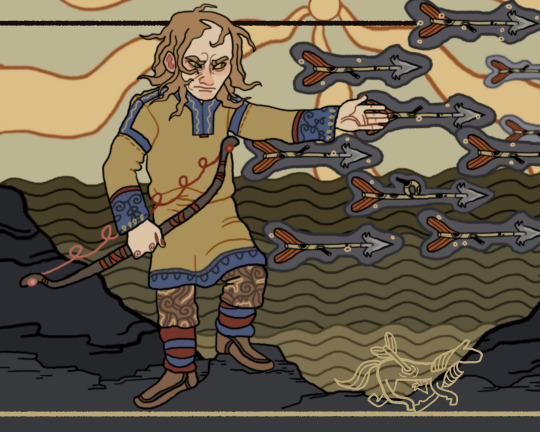
"Nevermore, old Väinämöinen,
Nevermore in all thy life-time,
While the golden moonlight glistens,
Nevermore wilt fix thy vision
On the meadows of Väinölä,
On the plains of Kalevala;
Full six years must swim the ocean,
Tread the waves for seven summers,
Eight years ride the foamy billows,
In the broad expanse of water;
Six long autumns as a fir-tree,
Seven winters as a pebble;
Eight long summers as an aspen!"
#my art#karjala#Kalevala#Kalevala Epic#Väinämöinen#Joukahainen#rune 6#rune VI#Elias Lönnrot#Karelian folklore#Finnish folklore
93 notes
·
View notes
Text


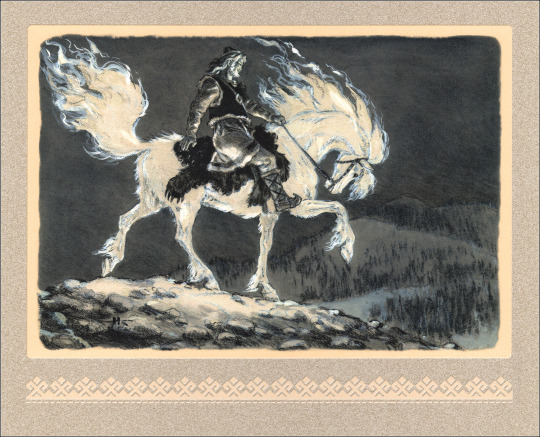
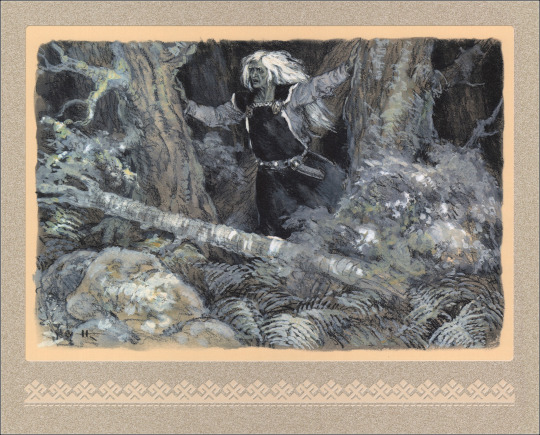



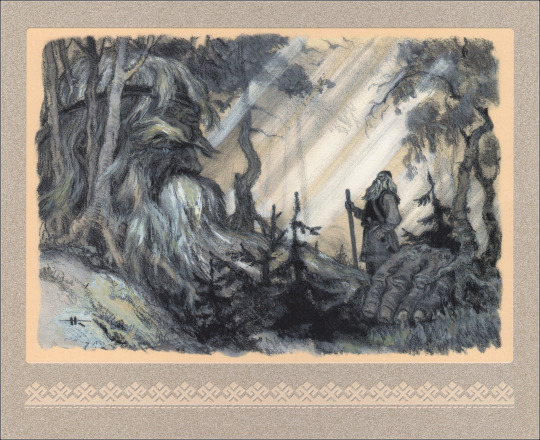


Kalevala
Illustrator Nikolai Kochergin
3 of 7
105 notes
·
View notes
Text
its national kalevala day. here’s my kalevala post:
ilmarinen is babygirl.
#väinämöinen mansplains manipulates and manwhores#lemminkäinen has huge glutes i know this cause väinämöinen appeared to me in a dream and told me#kalevala#blorbos from my karelian folklore
3 notes
·
View notes
Text
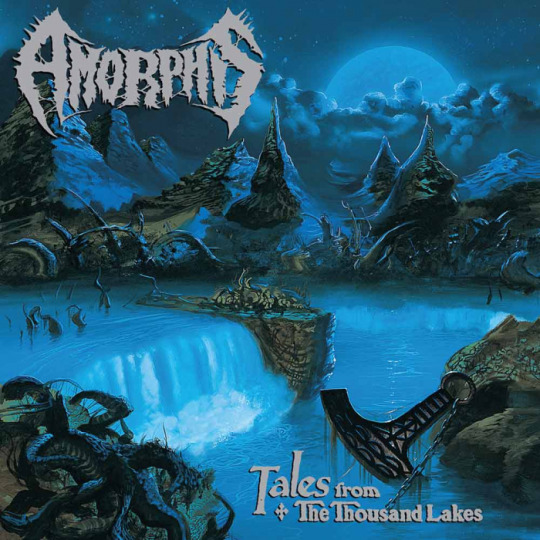

281. Tales from the Thousand Lakes - Amorphis (Melodic Death Metal, 1994)
Art by Sylvain Bellemare
The lyrics originate from a translation of the "Kalevala" - a 19th-century work of epic poetry compiled by Elias Lönnrot from Karelian and Finnish oral folklore and mythology.
The Kalevala is regarded as the national epic of Karelia and Finland and is one of the most significant works of Finnish literature
#as i am currently travelling far beyond the arctic circle and today also marks the day where this blog gets one year old#this was a no brainer to choose for the “anniversary” album - one of the first metal bands i ever listened to!#also thank you all for sticking around - for providing me with great music - conversation and more!#vacation queue#metal#melodic death metal#amorphis#art#artwork#music#painting#drawing#illustration#heavy music#artist#cover art#heavy#finnland#helsinki
45 notes
·
View notes
Note
i don't want to be ignorant, i'm just curious, how are Karelian people indigenous? i don't want to offend you with the question, it's just that when reading about Finnish history you see them integrating Karelian culture, identity and folklore so hard into it, it's difficult to me as an outsider to draw the line.

from my FAQ (link)
also like... how is finns stealing our shit bc they see us as primitive subhumans n thus closer to "Real Ancient Finnish Culture" a point against us being indigenous or different from finns? the finnish national identity as we know it now started to build in the late 1800s during the rise of finnish nationalism, in which they started looking into karelian and sámi cultures for inspo for their Official Finnish Cultural Identity bc they thought their own culture wasnt exotic n interesting enough. meanwhile karelians have been mentioned by name in texts from as far back as the 400s. finns only see karelians n our culture as finnish whenever it benefits them, but they had no issues trying to prove to the nazis that karelians were the real subhuman race and not them via graverobbing and skull measuring, or putting us into concentration camps run by mannerheim to 'purify' finland from the races that are too filthy for finland.
118 notes
·
View notes
Text

Augury
21 x 28 cm ✦ Indian and coloured ink on paper
The pike has a special part to play in old folklores of the Finnish, Karelian and Sámi peoples, with various beliefs connected to it. This respected and even feared creature was in some myths thought to have supernatural powers, like ability to travel down into the world of the dead and back. When fishing, if you happened to catch an unusually large pike, it could be seen as a death omen; a sign that you'd soon be traveling to the beyond along with the monstrous fish.
Folklore around the pike isn't all about death, though. Some peoples thought it to be the ancestor and protector of all fish, and it's bones were believed to have magical powers. They could be used in divination or spellcasting, usually to ask for a good harvest. Some people would even keep a "pet" pike in a well or a spring, to give protection and bring good fortune to it's keepers.
I feel like nowadays these myths are mostly treated as just tales, but they tell a fascinating story on the significance this animal used to bear to the people living in this part of the world.
Print shop ✦ Instagram
#art#artwork#artists on tumblr#art on tumblr#small artist#traditional art#original art#painting#ink painting#wildlife art#animal art#fish art#folklore art#finnish artist#nature art#nature#animals#fish#folklore#mythology#finnish folklore#fun fact: my boyfriend posted this on the 'mildly penis' sub reddit PFFF#I mean... not intentional but I see it lol#so#mildly penis
55 notes
·
View notes
Photo

Meaning of the stems of the words for "rainbow" in the languages of Europe.
by u/nickanc
'Rainbow' is typically a compound word in most European languages. Generally, speaking, a part of the word comes from words meaning bow, belt, ring, circle or arc in their respective languages or ancestor languages. The other one varies and is the main concern of this work.
Some incomplete notes on the meanings and the etymologies I gathered while making the map:
'sky god' + 'arc/bow':
Arabic from Quzah, a pre-islamic deity of weather
Maltese from Maltese alla 'god', from Allah, the islamic deity,
Karelian from Ukko, Finnic sky god
Lithuanian from Vaiva, goddess of Baltic mythology
Armenian is uncertain, supposed to derive ultimately from PIE *dyew- 'shine'
from PS *dǫga "bow". they all are not compounds, except maybe for Russian
'rain/flow'+'bow/arc':
Germanic ones but faroese from PG *regnaburô 'rainbow' obvious compound, *burô comes from PIE *bhewgh-
Faroese æla means shower (as in weather), formerly "flow quickly", from PG *ēlaz "eel"
Finnish from Proto-Finnic *satadak "fall, rain"
Irish and Scot Gaelic are compound words in their very language, there are many other interesting Irish words.
'arc of the old lady' and 'circus bibit', 'arcus bibit'. In some ancient folklore tales, that appear in various IE families, various weather phenomena are especially linked with magical or religious figures that assume the form of old ladies. In Italian and Romanian folklore there are the 'giorni della vecchia'/'zilele babelor' that are the days 29th-31st of March, when the cold is expected to return. In Romania an old lady is Baba Dochia that brings forth the spring and various other Babele populate the Romanian folklore; in the Gallo-italic folklore of Italy there is a folklore fog spirit named Borda that is an old lady personifying the fog, Gaelic mythology has its weather old lady Cailleach, the Indian summer is called in German Altweibersommer lit. 'old women's summer'. The rainbow is no exception: Plautus in the Curculio hints at a folktale of an old lady that drinks "like" the rainbow does or maybe is the rainbow itself, hence also other etymologies for rainbow related to expressions like "circus bibit", "arcus bibit", "arcus imbibens" etc.that give etymologies in various languages. Venetian arcombé and Ladin ergabuan come from arcus imbibiens (source), whereas Romanian curcubeu likely from curvus bibit and Neapolitan arcovevere from arcus bibit. Note that expressions containing the rainbow and the old lady or the act of drinking exist in many languages in this map and their dialects, just they are not the common word for rainbow. For example, in Moldovan there is brîul babei that means 'rainbow' (source), Slovenia has the dialectal word pijâvka 'rainbow' from PS *piti 'to drink', while in Spain and Portugal dialectal expressions that are cognates of the Galician one are apparently common, in Czech there is an idiom pije jak duha that means 'drink like a rainbow', i.e. being a drunkard. Ultimately all what I found points to a 1952 article of Gerhard Rohlfs, Romanischer Volksglaube um die Vetula, which however I was not able to find. EDIT: The Hungarian word is linked to the image of drinking the rainbow too, see below.
'thunder'+'arc' or 'arc'+'thunder':
Estonian is apparently cognate with Livonian pit'kiz kor(?) 'rainbow', lit. 'thunder bow', according to this source, though this comment offers more insight on the origin of the word.
Italian arcobaleno where baleno means flash, thunder, apparently from balena, 'whale', due to a popular habit to make many phenomena zoomorphic or anthropomorphic (the map I posted for fog in northern Italy presents a similar case with she-wolves). Alternatively, there is an article supposedly connecting the words of the 4. with arcobaleno: they suggest that, at some stages of the languages and the sociocultural development, the old lady was an old lady of the sea, thus a whale and their witness would be Galician vella 'old lady' which - according to that article - is a word that could mean also whale. The article is aimed ultimately to strengthen the Paleolithic Continuity Theory, so probably there is little to no scientific consensus on it, though at least I hope their examples are not as disputed as their conclusions.
color: teal. from word meaning "rain":
Polish from(?) OCS тѫча 'rain' and cognate with Russian ту́ча 'rain cloud'
Northern Sami related with Northern Sami arvedálki 'rainy weather'
Basque: 'horn of the sky' or 'sky god's horn', from Basque Urtzi
'arc'+figure of Christian religious figure (Saint John, Saint Martin, Saint Mark, Noah, the Virgin). The choice of the figure seems related to the days of these saints (St. Martin is during the Indian summer, related to 4.), though I have not that much experience on the topic to ascertain that. Noah is clearly linked with rain.
color: green. literally 'arc'+'holy woods', from Proto-Celtic *nemētom, cognate to Latin nemus 'wood' from PIE *nem- 'give, take' source, apparently suggesting a sacred role for the rainbow in Celtic traditions.
Curiosity, not sure if or how it is related to 9. and the other words conveying a sacred meaning for rainbow: in southern Italy, the rainbow was superstitiously considered the cause of jaundice, as màlë du uàrchë is jaundice (source]
273 notes
·
View notes
Text
Dnd lore is sometimes so bewildering to run into in the wilderness of the online world. I've been long aware of Loviatar having been pulled into the pantheon from karelian/finnish folklore and that it's been completely divorced from the original context. But it's still so wild to come across it in English-speaking spaces because it's a rarely used name of a less-world-famous character attached to something So Not It, so it's jarring in itself.
But then sometimes I run into a homebrew of her that - probably only being aware of the dnd context - puts a whole new spin on that version and cartwheels the deity into the orbit, leaving my mind spinning as I'm trying to bridge the gap between what I'm culturally internalized as Loviatar and whatever madness it is now carrying her name.
#random musings#I also wanna emphasize I don't find it offensive or bad#it's more just the bewildering sense of okay whoah uh hm loviatar huh#sure okay cool cool whatever#when all that's in my head is a dry-looking harpy lady duking it out with a man in a silly hat on a boat
16 notes
·
View notes
Text

Recovery of Lemminkäinen's head from the river of Tuonela (Hades).
Lemminkäinen was a worrior who met his death in a cruesome manner and his body was chopped into pieces and drowned in a river. His mother goes to look for the pieces by raking the river. She finds the pieces of his body and with the help of a bee who flies to heavens to get ointments that bring Lemminkäinen back to life.
Falling in love wiht Kalevala. It's a book of poems based on Karelian folklore.
#kalevala#lemminkainen#lemminkäinen#death#northern mythology#myth#mythology#karelian mythology#nordic mythology#finland#russia#karelia#finnish#karelian
12 notes
·
View notes
Text
Cow Names in "The Kalevala", a 19th-century work of epic poetry compiled by Elias Lönnrot from Karelian and Finnish oral folklore and mythology. The suffix -kki was common in cow names.
Apple (Omena), poem 32
Blackie (Muurikki), poems 1, 11; a black cow
Brandle (Kirjas)
Brindle (Kirjos), poem 32; a brindle or streaked cow.
Eater (Syötikki), poem 32; a cow that eats lots of fodder.
Drinker (Juotikki), poem 32; a cow that drinks a lot of water.
Freshness (Tuorikki), poem 32; a cow yielding an abundance of milk.
Frisky (Kimmo), poem 1; a frisky, lively cow.
Strawberry (Mansikki), poem 11
Stringy (Hermikki), poem 32; a lean cow with sinews showing
Sweetie (Mairikki), poem 32
Teenie (Pienikki), poem 32
Whortleberry (Puolukka), poem 11
#booklr#folklore#cows#cowstagram#cow names#just random stuff#in the glossary amongst deities and locations were cow names#mythology#finnish#kalevala#cowblr#cattle#literature
42 notes
·
View notes
Text

[Image above+below: works of an Estonian artist, Kaljo Põllu (28 November 1934 – 23 March 2010) ]
Legends and myths about trees
Forest myths, Estonian traditional beliefs (2)
The world of the Estonians’ ancestors - Proto-Estonian mythology
The world of the Estonians’ ancestors is believed to have turned around a pillar or a tree, to which the skies were nailed with the North Star. The Milky Way (Linnutee or Birds' Way in Estonian) was a branch of the World tree (Ilmapuu) or the way by which birds moved (and took the souls of the deceased to the other world). These myths were based on animistic beliefs.
Some traces of the oldest authentic myths may have survived in runic songs. There is a song about the birth of the world – a bird lays three eggs and starts to lay out the nestlings – one becomes Sun, one becomes Moon and one becomes the Earth. Other Finnic peoples also have myths according to which the world has emerged from an egg.
It has been suggested by ethnologist and former president Lennart Meri and among others, that a Kaali meteorite crater which passed dramatically over populated regions and landed on the island of Saaremaa around 3,000 - 4,000 years ago was a cataclysmic event that may have influenced the mythology of Estonia and neighboring countries, especially those from whose vantage point a "sun" seemed to set in the east.
There are surviving stories about Kaali crater in Finnish mythology (Description of indigenous paganism by Finns who always believed in spirit beliefs).
In the Karelian-Finnish folk epic, the Kalevala, cantos (songs) 47, 48 and 49 can be interpreted as descriptions of the impact, the resulting tsunami and devastating forest fires. It has also been suggested that the Virumaa-born Oeselian god Tharapita is a reflection of the meteorite that entered the atmosphere somewhere near the suggested "birthplace" of the god and landed in Oesel.
Estonian mythology is a complex of myths belonging to Estonian folk heritage and literary mythology, and the systematic documentation of Estonian folklore had only began in the 19th century.
Therefore, information on Proto-Estonian mythology before the conquest of the Northern Crusades, Christianisation and incorporation into the European world and during the medieval era, is only scattered in historical chronicles, travellers' accounts and in ecclesiastical registers.
It can be difficult to tell how much of Estonian mythology as we know it today was actually constructed in the 19th and early 20th century. Friedrich Robert Fehlmann, one of the compilers of the Estonian national epic, Kalevipoeg in the introduction to Esthnische Sagen (Estonian Legends), states.
"However, since Pietism has started to penetrate deep into the life of the people...singing folk songs and telling legends have become forbidden for the people; moreover, the last survivals of pagan deities are being destroyed and there is no chance for historical research."

木にまつわる伝説・神話
森の神話・エストニアの民間伝承 (2)
エストニア人の祖先の世界 〜 原始エストニア神話
エストニア人の祖先の世界は、柱または木の周りを回っていたと信じられており、その柱には北極星とともに天空が釘付けにされていた。天の川(エストニア語ではリヌーテーまたは鳥の道)は世界樹(イルマプー)の枝であり、鳥が移動する(そして亡くなった人の魂をあの世に連れて行く)道であった。これらの神話はアニミズム的な信仰に基づいていた。
最古の本物の神話の痕跡が、ルーン文字の歌詞の中に残っているかもしれない。ある鳥が3つの卵を産み、雛を産み始める。ひとつは太陽になり、ひとつは月になり、ひとつは地球になる、という世界の誕生の歌がある。他にはフィン族にも、世界が卵から生まれたという神話がある。
3,000~4,000年前に人口密集地域の上空を劇的に通過し、サーレマー島に落下したカーリ隕石 (カーリ・クレーター) は、エストニアや近隣諸国、特に「太陽」が東に沈むように見えた国々の神話に影響を与えた可能性がある、と民族学者で元大統領のレンナルト・メリらによって示唆されている。
フィンランド神話 (精霊信仰を常に信仰していたフィン族による原始宗教的な伝説) にカーリ隕石に関する物語が残っている。カレリア・フィンランドの民俗叙事詩『カレワラ』の第47、48、49カント (聖歌) は、その衝撃と、その結果生じた津波、壊滅的な森林火災についての記述であると解釈できる。また、ヴィルマア生まれのオイセルの神タラピタは、この神の「出生地」とされる場所の近くで大気圏に突入し、オイセルに落下した隕石の反映であるとも言われている。
エストニア神話は、エストニアの民間伝承と文学的神話に属する神話の複合体であり、エストニアの民間伝承の体系的な記録が始まったのは19世紀になってからである。そのため、北方十字軍の征服、キリスト教化、ヨーロッパ世界への併合以前、そして中世のエストニア神話の原型に関する情報は、歴史年代記、旅行者の記録、教会の記録に散見されるのみである。
今日私たちが知っているエストニア神話のどれだけが、19世紀から20世紀初頭にかけて実際に構築されたものなのかを見分けるのは難しい。エストニアの民族叙事詩『カレヴィポエグ』の編纂者の一人であるフリードリヒ・ロベルト・フェールマンは、『エストニア伝説』の序文で次のように述べている。
“しかし、敬虔主義が人々の生活に深く浸透し始めて以来......民謡を歌い、伝説を語ることは、人々にとって禁忌となった; さらに、異教の神々の最後の生き残りは破壊されつつあり、歴史研究のチャンスはない。"
#trees#tree myth#tree legend#legend#mythology#folklore#estonian mythology#finnish mythology#kalevala#paganism#animism#north star#milky way#birds' way#world tree#nature#art#Kaljo Põllu#spirit beliefs#estonia
115 notes
·
View notes
Text

I'm reconstructing my plan to illustrate the "Kalevala" epic, so here's a little spoiler with Joukahainen
/I want to warn you that when drawing characters from "Kalevala", I based on my impressions and fantasy, so they may not match with other artists/
23 notes
·
View notes
Text



Kalevala
#kalevala#finnish#karelian#epic#finland#sun#praise the sun#mythology#folklore#illustration#art#nikolai kochergin
95 notes
·
View notes
Text
Witches that don't live in america: (specifically y'all in the deep north)
We can collect plants that grow around us naturally for spellwork.
Even if you don't have a lavender field growing around you, you can substitute certain herbs with others with similiar properties! For an example: you can collect pine sprigs as another enhancer of psychic ability.
You can replace smudge sticks with fallen bark. Dry it and use it as cleansing or just as an atmospheric enhancer.
Research your areas own foklore and natural life. For me it would be old Karelian folklore, different things for different regions and folklore!
Blessed be folks! <3
2 notes
·
View notes
Text
i get so excited about people learning that finland is an evil hell country that i tear up a little. we should talk about it more bc the PR project as a small innocent nation finland has is absolutely wild (and it works! how could a SMALL helpless country have such a horrible history waah!!!)
not only the wild history of finland and the finnish nation-state in general but finland and other nordics are currently actively oppressing our indigenous populations (the sami peoples) and finland for its part isnt even filling the bare minimum set by the EU last time i checked. the bar is on the floor and yet...
also theres ethnic groups finland is still actively stealing from every day, like how our national epic, kalevala, is largely constructed on aped karelian folklore by elias lönnrot.
theres just so much. its like a rot onion. you peel back a layer and find something worse every time. some sort of horrific microcosm of what happens when a communist revolution is crushed by fascist capitalists
like, finnish people were classified by nazis as a lower species closer to slavic people but thankfully finland did not hesitate for a moment to step on everyone else to get a leg up and managed to become honorary aryans by (looks at smudged writing on hand) allying with the nazis in ww2
and then every finn tried to forget so bad, hence the entire theory that claimed finland was just a poor tiny vulnerable state with no other choices than to ally with nazis because of the Circumstances (ajopuuteoria/driftwood theory). my god, there is more rot underneath. something truly sinister
6 notes
·
View notes